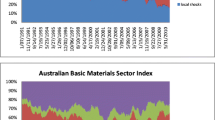Abstract
This article investigates factors that have influenced stock market valuations across a number of international markets. Previous studies have found that factors such as long bond rates and stock and bond volatilities have been able to describe how investors have historically set equity multiples in the United States. We find that these variables do not apply to non-US markets but that the relative rates of input and consumer inflation are important in explaining stock valuations internationally. A positive relationship is observed between the producer price inflation/consumer price inflation (PPI/CPI) ratio and stock yields, which we conjecture reflects investors’ concerns that rising commodity prices will manifest in reduced future profitability for companies and lower returns for equities. We observe that the PPI/CPI ratio is more convincing internationally at explaining equity valuations compared to the stock and bond volatility approach that has proved successful in the United States. Indeed, we also posit that the unprecedented price-earning ratios seen globally around the end of the twentieth century can be attributed in part to the extremely depressed real price of commodities at that time.

Similar content being viewed by others
Notes
For example, Fama and French (1998) show that value and growth are international effects.
For further discussion on international payout ratios see ap Gwilym et al (2006).
More recent examples are ‘The ShortView’, Financial Times, 13 August 2008, and ‘Are Equities a Shelter in Inflationary Times’, Financial Times, 1 September 2008.
We find no major problems with multicollinearity in these equations. All VIFs are 4.3 or below, with the exception of Japan, which is 5.9. While there is no absolute value at which a VIF indicates multicollinearity being an issue, we use a ‘rule of thumb’ of anything less than 10 being acceptable.
References
ap Gwilym, O., Seaton, J., Suddason, K. and Thomas, S. (2006) International evidence on the payout ratio, earnings, dividends and returns. Financial Analysts Journal 62 (1): 36–54.
Asness, C. (2000) Stocks vs bonds: Explaining the equity risk premium. Financial Analysts Journal 56 (2): 96–113.
Asness, C. (2003) Fight the fed model. The Journal of Portfolio Management 30 (1): 11–24.
Bernstein, P. (2005) Dividends and the frozen orange juice syndrome. Financial Analysts Journal 61 (2): 25–30.
Bodie, Z. (1976) Common stocks as a hedge against inflation. Journal of Finance 31 (2): 459–470.
Campbell, J. and Shiller, R. (1998) Valuation ratios and the long-run stock market outlook. Journal of Portfolio Management 25 (2): 11–26.
CRB Encyclopedia of Commodity and Financial Prices. (2006) New Jersey: John Wiley & Sons.
Dimson, E., Marsh, P. and Staunton, M. (2006) The worldwide equity premium: A smaller puzzle. London Business School (mimeo).
Faber, M. (2002) Tomorrow's Gold: Asia's Age of Discovery. Hong Kong: CLSA.
Fama, E. and French, K. (1998) Value versus growth: The international evidence. Journal of Finance 53 (6): 1975–1999.
Fama, E. and French, K. (2001) Disappearing dividends: Changing firm characteristics or lower propensity to pay? Journal of Financial Economics 60 (1): 3–43.
Glassman, J. and Hassett, K. (1999) Dow 36,000. New York: Random House.
Gorton, G. and Rouwenhorst, K.G. (2006) Facts and fantasies about commodities futures. Financial Analysts Journal 62 (2): 47–68.
Grantham, J. (2008) Immoral hazard. GMO Quarterly Letter, (April).
Grullon, G. and Michaely, R. (2002) Dividends, shares repurchases and the substitution hypothesis. Journal of Finance 57 (4): 1649–1684.
Ilmanen, A. (2003) Expected returns on stocks and bonds. Journal of Porfolio Management 29 (2): 7–27.
Lasfer, M. (2001) The market valuation of share repurchases in Europe. City University Business School (mimeo).
Lintner, J. (1975) Inflation and security return. Journal of Finance 30 (2): 259–280.
Modigliani, F. and Cohn, R. (1979) Inflation, rational valuation, and the market. Financial Analysts Journal 35 (March/April): 24–44.
Newey, W.K. and West, K.D. (1987) A simple, positive semi-definite, heteroskedasticity and autocorrelation consistent covariance matrix. Econometrica 55 (3): 703–708.
Oswald, D. and Young, S. (2004) What role taxes and regulation? A second look at open market share buyback activity in the UK. Journal of Business, Finance and Accounting 31 (1–2): 257–292.
Ritter, J. and Warr, R. (2002) The decline of inflation and the bull market of 1982–1999. Journal of Financial and Quantitative Analysis 37 (1): 29–61.
Sharpe, S. (2002) Reexamining stock valuation and inflation: The implications of analysts’ earnings forecasts. The Review of Economics and Statistics 84 (4): 632–648.
von Eije, H. and Megginson, W. (2008) Dividends and share repurchases in the European Union. Journal of Financial Economics 89 (2): 347–374.
Author information
Authors and Affiliations
Corresponding author
Rights and permissions
About this article
Cite this article
Clare, A., Gwilym, O., Seaton, J. et al. Explaining international equity valuation ratios: The roles of commodity price inflation and relative asset volatilities. J Asset Manag 12, 11–29 (2011). https://doi.org/10.1057/jam.2009.36
Received:
Revised:
Published:
Issue Date:
DOI: https://doi.org/10.1057/jam.2009.36




